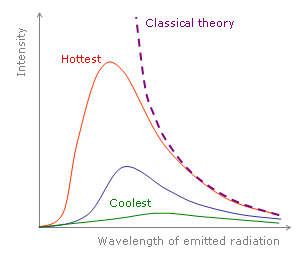Black body
|
|
In physics, a black body is an object that absorbs all light that falls onto it: no light passes through it and none is reflected. Despite the name, black bodies do produce thermal radiation such as light.
The term "black body" was introduced by Gustav Kirchhoff in 1862. The light emitted by a black body is called black-body radiation1.
In the laboratory, the closest thing to black-body radiation is the radiation from a small hole entrance to a larger cavity: if the hole is small, it 'absorbs' little energy from the outside and it 'radiates' all the energy from the inside which is black. However, the spectrum (i.e. the amount of light emitted at each wavelength) of its radiation will not be continuous, and only rays will appear whose wavelengths depend on the material in the cavity (see Emission spectrum). By extrapolating the spectrum curve for other frequencies, a general curve can be drawn, and any black-body radiation will follow it. This curve depends only on the temperature of the cavity walls.
Blackbody-colours-vertical.png
At 1000K the radiation appears bright red. At 3000K the color is orange. By about 6000K it appears nearly pure white. Above 6000 the color becomes slowly more blue. At 10000K the color is a sky-blue.
The observed spectrum of black-body radiation could not be explained by Classical electromagnetism and statistical mechanics: these predicted infinite brightness at low wavelength (i.e. high frequencies), a prediction often called the ultraviolet catastrophe.
This theoretical problem was solved by Max Planck, who had to assume that electromagnetic radiation could propagate only in discrete packets, or quanta. This idea was later used by Einstein to explain the photoelectric effect. These theoretical advances eventually resulted in the replacement of classical electromagnetism by quantum mechanics. Today, the quanta are called photons.
The intensity of radiation from a black body at temperature T is given by Planck's law of black-body radiation:
- <math>I(\nu) = \frac{2h\nu^{3}}{c^2}\frac{1}{\exp({h\nu}/kT)-1}<math>
where
<math>I(\nu)d\nu<math> is the amount of energy per unit surface per unit time per unit solid angle emitted in the frequency range between ν and ν+dν;
- T is Temperature
- h is Planck's constant
- c is the speed of light
- k is Boltzmann's constant
Pahoehoe_toe.jpg
The wavelength at which the radiation is strongest is given by Wien's law, and the overall power emitted per unit area is given by the Stefan-Boltzmann law. So, as temperature increases, the glow color changes from red to yellow to white to blue. Even as the peak wavelength moves into the ultra-violet enough radiation continues to be emitted in the blue wavelenths that the body will continue to appear blue. It will never become invisible—indeed, the radiation of visible light increases monotonically with temperature.
The radiance or observed intensity is not a function of direction. Therefore a black body is a perfect Lambertian radiator.
Real objects never behave as full-ideal black bodies, and instead the emitted radiation at a given frequency is a fraction of what the ideal emission would be. The emissivity of a material specifies how well a real body radiates energy as compared with a black body. This emissivity depends on factors such as temperature, emission angle, and wavelength. However, a typical engineering assumption is to assume that a surface's spectral emissivity and absorptivity do not depend on wavelength, so that the emissivity is a constant. This is known as the grey body assumption. When dealing with non-black surfaces, the deviations from ideal black body behavior are determined by both the geometrical structure and the chemical composition, and follow Kirchhoff's Law: emissivity equals absorptivity, so that an object that does not absorb all incident light will also emit less radiation than an ideal black body.
In astronomy, objects such as stars are frequently regarded as black bodies, though this is often a poor approximation. An almost perfect black-body spectrum is exhibited by the cosmic microwave background radiation. Hawking radiation is black-body radiation emitted by black holes.
Footnotes
Note 1: When used as a compound adjective, the term is typically hyphenated, as in "black-body radiation", or combined into one word, as in "blackbody radiation". The hyphenated and one-word forms should not generally be used as nouns, however.
References
- Planck, Max, "On the Law of Distribution of Energy in the Normal Spectrum (http://dbhs.wvusd.k12.ca.us/webdocs/Chem-History/Planck-1901/Planck-1901.html)". Annalen der Physik, vol. 4, p. 553 ff (1901).
- Descriptions of radiation emitted by many different objects (http://www.x20.org/library/thermal/blackbody.htm)ca:Cos negre
de:Schwarzer Körper es:Cuerpo negro fr:Corps noir ko:흑체 id:Benda hitam it:Corpo nero nl:Zwart lichaam ja:黒体 pl:Ciało doskonale czarne ru:Абсолютно чёрное тело fi:Musta kappale zh:绝对黑体

